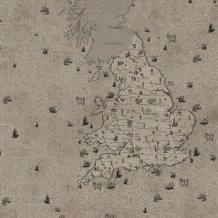
The project has engaged people of all ages and abilities to write about place, heritage and identity and then 'pin' their poems onto a distinctive digital map
Thousands of writers have been inspired by Britain's diverse landscape and heritage to produce new poems as part of one of the year's most successful arts projects, drawing to its conclusion this week.
Railway stations, villages, coffee shops, supermarkets and libraries all feature in the poems – now more than 6,500 – written as part of Places of Poetry.
The project has engaged people of all ages and abilities to write about place, heritage and identity and then 'pin' their poems onto a distinctive digital map, where everyone can read them.
The digital map has been created to encourage people to think about the environment and history around them. The map consists of two layers: an artistic map, based on decorative seventeenth-century county maps, and a second layer of Ordnance Survey data, allowing users to zoom in to a high level of detail.
Around 20,000 people so far have used the website to submit or read poems, with as many as 150 poems pinned on some days.
There are two poems pinned on the map about Didcot Parkway Station, odes to villages lost to the sea and for places which have disappeared such as coal mines or pubs. People have also pinned poems onto river estuaries between England and Wales
Places of Poetry is led by broadcaster and poet Paul Farley and University of Exeter academic Professor Andrew McRae. Places of Poetry events were held at some of the country's most spectacular places this summer, from Hadrian's Wall to the Oval and Stonehenge, with renowned poets such as Jo Bell, Kayo Chingonyi and Zaffar Kunial producing new work inspired by their Places of Poetry experience.
Professor McRae said: "It's been wonderful to see so many people pin poems to the map and take part in the project. Writers of all ages have written about so many places in the country, and about such a wide variety of topics, from football grounds to care homes. There are poems about rural and urban areas, showing there are so many different places which inspire us."
One of the most read poems on the map is On Winchelsea Beach by Geoff Marshall, a piece which demonstrates that landscape poetry can also be powerfully political, setting the security of an English beach in contrast with media images of refugees washed up on foreign shores.
Another popular poem is Two Sides of the Estuary by Lenka Medlik, which describes wind-a stunted thorn, frozen-grown- / grass streaming flat with the outgoing tide- / eyes wet, hair whipped wide- / but we lean into it, listening.
Thoughts on a king's idyll in City of the Legion (Caerleon), by Peter Gaskell, is another regularly read poem, as is Ardrossan, by "Wordwool", about wind which "strikes the face / Like being lifted in a dancer's arms / To the sound of a music / That is filled with memories and promise."
The Places of Poetry project is funded by the Arts and Humanities Research Council, The National Lottery Heritage Fund and Arts Council England, and is made possible by partnerships with the Ordnance Survey, The Poetry Society and National Poetry Day.






